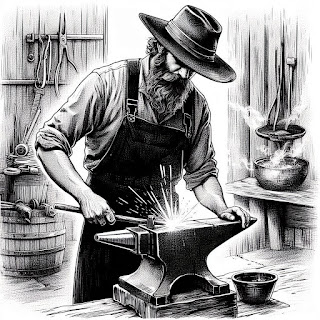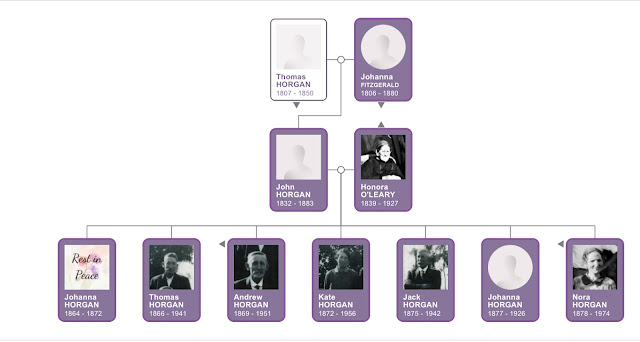 |
| AI generated and edited image in canva.com |
A review of my family history activities in 2024, prompted by Jill at Geniaus. She provides 20 prompts for writing a blog post, I have used only a few of these.
1. Google provided a lead for a distant relative of my husband when he found one of my blog posts referring to his ggt-grandfather.
2. I was the recipient of genearosity from a distant relative in South Australia who continues to investigate our Byrne family connections.
3. This was a headstone I had not previously not seen. My husband's paternal grandmother.
4. A useful record I discovered was the will and probate record for Timothy Hogan by using fulltext search in FamilySearch Labs.
5. A newly found family member shared details of his Bennett grandparents, their children and some of their descendants.
6. A geneasurprise I received was another contact who was following my husband's great grandparents. His mother then forwarded some photos not previously seen.
7. My 2024 post that I was particularly proud of was Easter offerings 1895 where I enumerated the attendees at a small country church that Sunday morning with some brief details about each one.
8. DNA helped me to consolidated one branch of the Horgan family tree by confirming several 3rd cousins and 2nd cousins one removed in that line.
9. I was pleased I upgraded to the pro tools on Ancestry which provided further clues on some DNA connections. I also upgraded my laptop after failing to find a solution to maximise efficiency on my 9 yr old device. It was so slow. Another upgrade arrived via Santa, a new Android phone.
10. Although Face to Face events have returned Zoom has enabled me to participate in many sessions that would otherwise be unavailable in my home location.
11. I dipped my toes into suno.com where I provided some basic details about my brother's life and had a song generated for his 80th birthday celebration.
12. I connected with a Bennett descendant in the USA via two DNA matches.
13.By dipping into a range of AI tools I was able to refine and edit some text for my family history book published this year. Transkribus.ai enabled quick transcription and correction of 43 letters written home during World War II.
14. I was honoured to be asked to present a session for QFHS in February 2025
15. It was exciting to meet face to face with a previously unknown second cousin found through his daughter's DNA results.
16. A geneadventure I enjoyed this year was and is a virtual one. I am using WeAre.xyz where I am storing and sharing our family stories and photos.
17. Another positive I would like to mention was that I refined my A-Z posts from 2017 about my childhood into a printed booklet which I then gave to my son on Christmas Day. He expressed his delight at the personal gift. Two of his three boys expressed interest, there is hope for the future of our family history.
3. This was a headstone I had not previously not seen. My husband's paternal grandmother.
4. A useful record I discovered was the will and probate record for Timothy Hogan by using fulltext search in FamilySearch Labs.
5. A newly found family member shared details of his Bennett grandparents, their children and some of their descendants.
6. A geneasurprise I received was another contact who was following my husband's great grandparents. His mother then forwarded some photos not previously seen.
7. My 2024 post that I was particularly proud of was Easter offerings 1895 where I enumerated the attendees at a small country church that Sunday morning with some brief details about each one.
8. DNA helped me to consolidated one branch of the Horgan family tree by confirming several 3rd cousins and 2nd cousins one removed in that line.
9. I was pleased I upgraded to the pro tools on Ancestry which provided further clues on some DNA connections. I also upgraded my laptop after failing to find a solution to maximise efficiency on my 9 yr old device. It was so slow. Another upgrade arrived via Santa, a new Android phone.
10. Although Face to Face events have returned Zoom has enabled me to participate in many sessions that would otherwise be unavailable in my home location.
11. I dipped my toes into suno.com where I provided some basic details about my brother's life and had a song generated for his 80th birthday celebration.
12. I connected with a Bennett descendant in the USA via two DNA matches.
13.By dipping into a range of AI tools I was able to refine and edit some text for my family history book published this year. Transkribus.ai enabled quick transcription and correction of 43 letters written home during World War II.
14. I was honoured to be asked to present a session for QFHS in February 2025
15. It was exciting to meet face to face with a previously unknown second cousin found through his daughter's DNA results.
16. A geneadventure I enjoyed this year was and is a virtual one. I am using WeAre.xyz where I am storing and sharing our family stories and photos.
17. Another positive I would like to mention was that I refined my A-Z posts from 2017 about my childhood into a printed booklet which I then gave to my son on Christmas Day. He expressed his delight at the personal gift. Two of his three boys expressed interest, there is hope for the future of our family history.
This post first appeared on earlieryears.blogspot.com by CRGalvin





.jpg)































